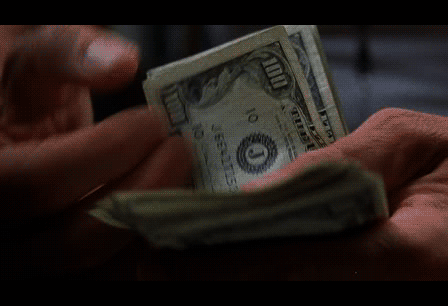How to Win When Your Opponent Straddles (3 Crucial Tips)
Adding a poker straddle to the game creates a whole new set of dynamics which are not so easy to figure out on the fly.
However, learning how to play well with a straddle in play is important for your bottom line since pots will be much bigger and stacks will be flying back and forth.

In this article, I am going to share with you 3 tips to help you understand what adjustments you need to make when there is a straddle on.
Let’s dive in!
1. Raise to a size proportional to the straddle
In a regular cash game, we should typically raise somewhere between 2.2 and 3 big blinds. These sizes accomplish many things:
- We get a good price on our raise.
- The big blind player will be forced to defend with a relatively wide and weak range, which he will have to play out of position.
- The players behind don’t have great pot odds to call.
When a straddle is in play, it basically acts as the new big blind. So, the optimal approach is to base our sizing on the straddle size, like we based our size on the big blind before.
So, if we would normally raise to 3 big blinds, when there is a straddle involved, we should now raise to 6 big blinds or 3 straddles. For example, if we have $500 in a $2/$5 game and someone posts a $10 straddle, we would raise to $30.
If we’re in a game where larger raise sizes (4+ big blinds) are standard, we should only raise to that same number of straddles if we are playing deep stacked. Otherwise, we should go back to our 3 straddle raise size. We don’t want to find ourselves raising to, say, $20 in a $1/$2 game with a $4 straddle if most players at the table are short-stacked.
One final adjustment is to raise larger (4+ straddles) against players who play particularly loose versus raises after they’ve straddled. I’ve seen players defend their straddle with hands like 62o, which is obviously a huge mistake! If the player straddling seems like he won’t give up without a fight, we should raise to a larger size then recommended above.

2. Tighten your raising ranges
There are two important factors to consider when thinking about how frequently we should open-raise:
- How many players are left to act. The more players there are behind, the fewer hands we should raise and vice-versa.
- How many players left to act have position on us. Having position on more players allows us to play looser.
Let’s look at these factors under a regular blind structure compared to a straddle structure for the cutoff, button, and blinds:
With this table in mind, let’s take the button as an example.
In a regular game, the button has 2 players behind and is in position against both of them. A good button raising range would be about 40% of hands in this very common spot, which looks like this:
40% button raising range from Elite Cash Game Mastery (Red = Raise, Blue = Fold)
When the straddle is on, the button has 3 players behind and is in position against all of them. This means that the optimal raise first in frequency is going to be lower than 40% because there are more players left to act than before.
We can use logic to estimate roughly how much lower of a frequency we need to raise. In this case, we should take a look at the cutoff raising range for a regular game because it also has 3 players behind:
26% cutoff raising range from Elite Cash Game Mastery (Red = Raise, Blue = Fold)
But we can actually play a bit looser than this because, unlike the cutoff in a regular game, we have position on all 3 players left to act.
So, we can say for certain that the button raising range with a straddle in play should be somewhere in between the 40% and 26% ranges above. If we take the average of those two percentages, we get 33% of hands, which looks like this:
33% button range with straddle in play (Red = Raise, Blue = Fold)
This method won’t provide us with the exact optimal frequency, but it will certainly be close.
We can follow the same process to work out ranges for all of the other positions.
3. Adjust your postflop strategy to the stack-to-pot ratio
We might have bought in for 100 big blinds, but that’s basically 50 blinds when a straddle is on. This halving of stacks reduces the stack-to-pot ratio, which changes the optimal strategy.
Let’s compare the stack-to-pot ratios in a regular game compared to a straddle game (assuming each player has a 100 big blind stack).
If a player raises to 2.5 big blinds and gets one caller in a regular game, there will be around 6 big blinds in the pot on the flop with 97.5 big blinds behind. That makes the stack-to-pot ratio 15.75, which is quite deep.
If a player raises to 2.5 straddles and another player calls in a straddle game, there will be around 6 straddles in the pot on the flop with 47.5 straddles behind. That makes the stack-to-pot ratio 8, which means players have less room to maneuver than in the regular game.
Now, suppose a player raises to 2.5 big blinds and then calls an 8.5 big blind 3-bet from another player. On the flop, there will be around 18 big blinds in the pot with 91.5 big blinds behind. The stack-to-pot ratio, in this case, is just above 5.
So, just to recap these stack-to-pot ratios:
- Single raised pot, regular game: 15.75
- Single raised pot, straddle game: 8
- 3-bet pot, regular game: 5
We can see that the ratio in a single raised pot in a straddle game is fairly close to the ratio in a 3-bet pot in a regular game. For this reason, the optimal strategy will be more straightforward, which means:
- We should fast-play our strong hands more often.
- Protecting our ranges isn’t as important.
- Strong-but-not-amazing hands like top pair go up in relative value.
We’re basically playing shorter-stacked poker, which segues nicely into our final section.
A Quick Word on Playing with Shallow Stacks
Since many of you reading this will encounter straddles in $1/$3 and $2/$5 games, I feel compelled to include some adjustments for when you or your opponents are short-stacked.
As stacks diminish in size, your preflop strategy should start to shift. We will start to value high card hands more and speculative hands (suited connectors and small pairs) less. This is because implied odds go down with short stacks, which makes chasing sets, flushes, and straights less enticing.
When playing against players with short stacks, say around 20 or so straddles, you should raise smaller than 3 straddles preflop. That way, your opponent won’t make as much money when they shove over your raise and you are forced to fold. Continuing to raise large basically gives their 3-bet shoving range free money.
That’s all for today. If you found this article useful, please share it with your friends!
Good luck out there, grinders!